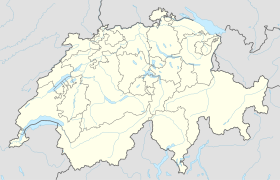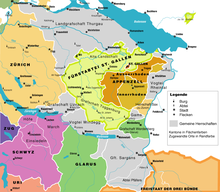Werdenberg SG
| SG is the abbreviation for the canton of St. Gallen in Switzerland and is used to avoid confusion with other entries of the name Werdenberg . |
| Werdenberg | ||
|---|---|---|
| State : |
|
|
| Canton : |
|
|
| Constituency : | Werdenberg | |
| Political community : | Grabs | |
| Postal code : | 9470 | |
| UN / LOCODE : | CH WDB (Werdenberg) | |
| Coordinates : | 753 474 / 226124 | |
| Height : | 451 m above sea level M. | |
|
Castle and town of Werdenberg |
||
| map | ||
|
|
||
Werdenberg is a town with historical town charter in the eastern Swiss canton of St. Gallen . The town of Werdenberg belongs to the municipality of Grabs and is located 0.5 km west of Buchs . It prides itself on being the smallest town in Switzerland with around 55–60 inhabitants. Some of the 40 or so houses are only used as holiday homes. Due to its very well-preserved medieval houses and the museum in Werdenberg Castle, Werdenberg is often visited by tourists. The Werdenberg Castle Festival has been taking place in Werdenberg Castle since 1985 .
Werdenberg county
The county of Werdenberg included the castle of the same name and town of Werdenberg, the villages of Grabs, Buchs and Sevelen, and jurisdiction over the rule of Wartau (Wartau Castle and Gretschins village). The noble family of the Counts of Werdenberg split into several side lines in 1277. The actual county of Werdenberg remained with the line of the Counts of Werdenberg- Heiligenberg .
In 1402 they pledged the County of Werdenberg to the Counts of Montfort-Tettnang , from whom it came to the Counts of Sax-Misox in 1483 . In 1485 the city of Lucerne acquired the county and in 1493 passed it on to the barons of Kastelwart . However, through a castle law with Lucerne, the county remained connected to the Swiss Confederation, even when in 1498 the county again changed hands to the barons of Hewen . In the Swabian War, Werdenberg also fought alongside the Confederates. In 1517 the barons of Hewen sold Werdenberg to the canton of Glarus for 21,500 guilders.
Werdenberg administered Glarus very strictly as a bailiff - the Glarus lords were anything but popular in the Rhine Valley . Because of the confused legal situation between the counties of Werdenberg and Sargans in the rule of Wartau , there were repeated disputes between the provincial bailiffs, which in the " Wartau trade " in 1694/95 were carried up to the federal diet .
With the fall of the old Confederation and the establishment of the Helvetic Republic in 1798, Werdenberg became part of the canton of Linth . When this was dissolved again with the mediation constitution of 1803, Werdenberg came to the canton of St. Gallen .

Burgers and Strikers
There were two age-old corporations in the county of Werdenberg that were dissolved in 2010 because they had lost their original purpose for over 150 years:
The citizens
The original Werdenberger burgers have no connection with the Werdenberg local communities. When the counts built Werdenberg Castle and Palace in the 13th century, they probably also brought their followers with them. They built their houses on and within the city walls, hence the name 'burger'. They had duties prescribed by the rulership, such as guarding the town and castle, and in return they were exempt from most of the duties that other subjects had to pay. For centuries, burgers could only call themselves those who lived within the city wall (“housekeeping”). Since the sovereigns were rarely located in Werdenberg at that time, the citizens organized themselves in a corporation, they enjoyed great freedom for the conditions at the time, they could appoint the mayor and other important offices from their ranks and even built their own town hall in the Städtli around 1478 at Obern Tor (today owned by the Canton of St. Gallen and served as a school building for around 200 years). They also owned the only butcher in the county, several forests and meadows, and the right to mill.
In the course of time, the burgers increased and could not all live within the city wall. Those who settled outside were now called Usburger and those inside "Inburger". “Usburgers” no longer had the same rights as the “Inburger”, but still enjoyed many privileges compared to the common subjects (serfs). "Usburgers" settled in the entire county (the Kilch or comrades in Grabs, Buchs and Sevelen) and all had the same rights. The then “Inburger” and “Usburger” all later reunited as the “Burgerkorporation der Grafschaft Werdenberg”. It was not until 1818 that the citizens and their property were divided between the three municipalities of Grabs, Buchs and Sevelen, and they all existed independently well into the 20th century. The original burger genders are unknown. The oldest written mention of a house owner, probably in Städtli, dates back to 1294: "... ze Werdenberg in Uolrichs hus des Litsche ..." an arbitration award takes place in the presence of Count Hugo von Werdenberg. That Ulrich Litscher - the gender still exists - was a burger, but it is not certain. In 1303 a "Litscher von Werdenberg" appears who had a farm and vineyards from the St.Gallen monastery as a fief in Lüchingen . A "Johannes Litscher" appeared in 1349 as a burger from the city of Feldkirch, and a "Joseph Litscher" sold a noble residence in Vaduz in 1425 following emigration. Dozens of genders appear and disappear over the centuries. Marriage and shopping brought new names and many died out due to a lack of descendants. The burger genders known for example in Grabs until around 1990 have by no means been the same since the beginning.
The strikers
According to the oldest written evidence, the Stürer organized themselves as a corporation, probably in the 15th century. The "Stürsgnossen" were made up of the so-called "Landlüten", locals from all three county communities who were not exempt from any levies to the authorities. It is assumed that the term “sturgeon” has nothing to do with today's taxes, but rather describes the term “steer together”. The “Stürer” - like the “Burgers” - ran a joint fund, from which they - like the “Burgers” - lent their fellow mates mainly on real estate against interest and paid out the interest to everyone, including the penniless comrades. This was done by both corporations well into the 19th century, when the lending was completely taken over by the banks over time. In addition to the interest income, the coffers were also fed from so-called “deductions” and “purchases”, which were money that someone who settled in the county - or withdrew. The two corporations often argued and litigated over this and other income. The same applies to the sexes of the striker as to the sexes of the burger. They have changed constantly over the centuries.
Neither “Burger” nor “Stürer” could become the so-called “Hindersäss” (immigrant sexes), unless this also happened when someone had the necessary money for “shopping”, which was very expensive. The "free Walser" enjoyed a special status. As they originally lived far away from settlements, meadows and common areas in high, mostly inhospitable areas, they were exempt from all taxes. When they gradually pushed into lower levels and also wanted to participate in the general institutions and commons, this also led to many disputes and litigation over the years.
Attractions
Personalities
- Carl Hilty (1833–1909), von Grabs, constitutional lawyer and lay theologian
- Markus Vetsch (1759–1813), von Grabs, Werdenberg freedom fighter
literature
- Lorenz Hollenstein: Werdenberg. In: Historisches Lexikon der Schweiz ., With further references.
- Dieter Schindler: Werdenberg as Glarner Landvogtei: subjects, rural upper class and "foreign masters" in the 18th century . Buchs-Druck und Verlag, Buchs 1986, ISBN 3-905222-21-6 (separate print from: St. Galler Kultur und Geschichte, Volume 15).
- Historical and local history association of the Werdenberg region: Werdenberger Jahrbuch: Contributions to the history and culture of the communities of Wartau, Sevelen, Buchs, Grabs, Gams and Sennwald , BuchsDruck and Verlag, Buchs 1988, annually DNB 015426432 .
Web links
- Werdenberg region - information about the region, the economy and life in Werdenberg
- Picture gallery of Werdenberg Castle
- The legal sources of the Werdenberg region: County Werdenberg and Herrschaft Wartau, Freiherrschaft Sax-Forstegg and Herrschaft Hohensax-Gams [1]
Individual evidence
- ↑ Werdenberger Schlossfestspiele on the Swiss Tourism Association's website www.myswitzerland.com
- ^ Castle and town of Werdenberg A short story. (PDF) Retrieved July 28, 2018 .



